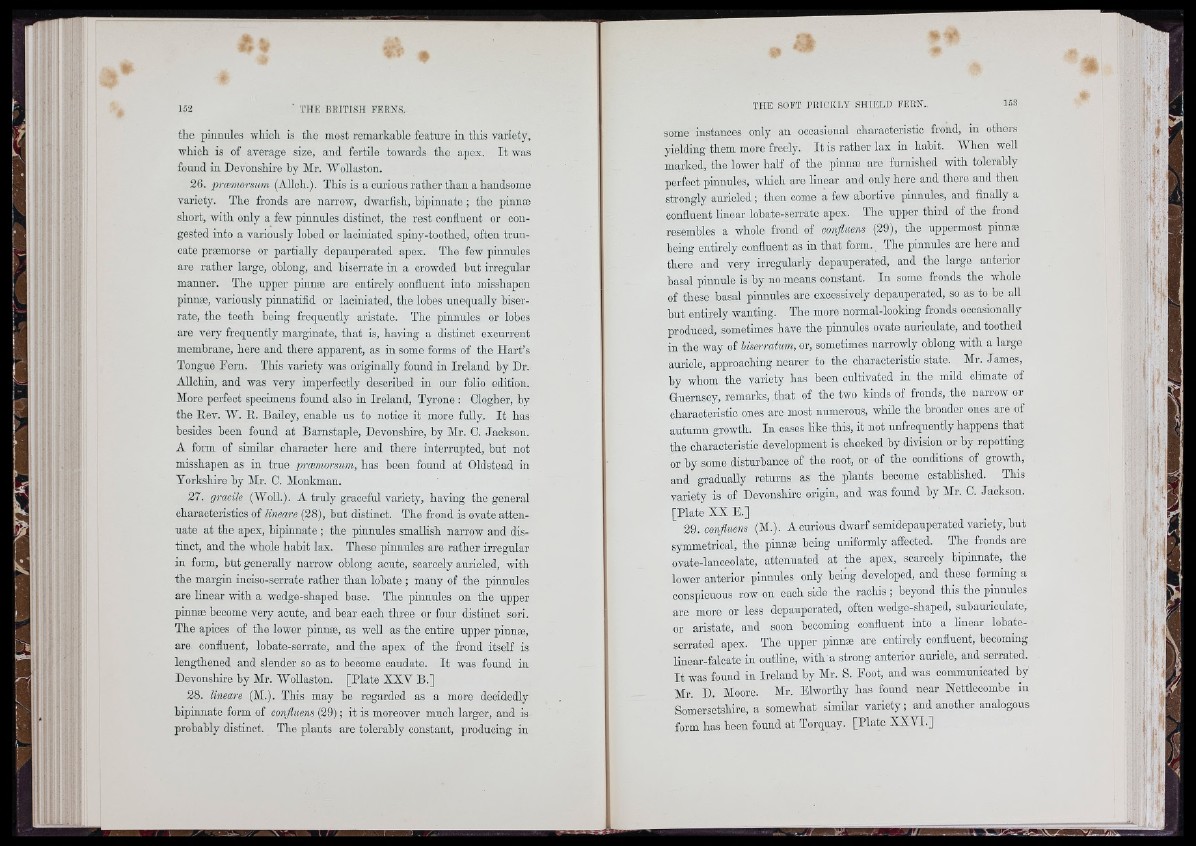
the pinnules which is the most remarkable feature in this variety,
which is of average size, and fertile towards the apox. I t was
found in Devonshire by Mr. Wollaston.
2C. præmommi (Allch.). This is a curious rather than a handsome
variety. Tho fronds are narrow, dwarfish, hipinnate ; the pinnæ
short, with only a few pinnules distinct, the rest confluent or congested
into a variously lobed or laciniated spiny-toothed, often truncate
præmorse or partially depauperated apex. The few pinnules
are rather large, oblong, and biserrate in a crowded but irregular
manner. The upper pinnæ aro entirely confluent into misshapen
pinnæ, variously pinnatifid or laciniated, the lobes unequally biserrate,
the teeth boing frequently aristate. The pinnules or lobes
are very frequently marginato, that is, having a distmot excurrent
membrane, here and there apparent, as in some forms of the H a rt’s
Tongue Forn. This variety was originally found in Ireland by Dr.
AUohin, and was very imperfectly described in our folio edition.
More perfect specimens found also in Ireland, Tyrone : Clogher, by
the Rev. W. R. Bailey, enable us to notice it more fully. I t has
besides been found at Barnstaple, Devonshire, by Mr. C. Jackson.
A form of similar character here and there interrupted, but not
misshapen as in true præmorsum, has been found at Oldstead in
Yorkshire hy Mr. C. Monkman.
27. gracile (Woll). A truly graooful variety, having the general
characteristics of limare (28), but distinct. The frond is ovate attenuate
at the apex, bipinnate ; the pinnules smallish narrow and distinct,
and the whole hahit lax. These pinnules are rather irregular
in form, hut generally narrow oblong acute, scarcely auricled, with
the margin inciso-serrate rather than lobate ; many of the pinnules
are linear with a wedge-shaped base. The pinnules on the upper
pinnæ become very acute, and bear each three or four distinct sori.
The apices of the lower pinnæ, as well as the entire upper pinnæ,
are confluent, lobate-serrate, and the apex of the frond itself is
lengthened and slender so as to become caudate. I t was found in
Devonshire by Mr. Wollaston. [Plate XXV B.]
28. lineare (M.). This may be regarded as a more decidedly
bipinnate form of confluens (29) ; it is moreover much larger, and is
probably distinct. The plants are tolerably constant, producing in
some instances only an occasional characteristic frond, in others
yielding them more freely. I t is rather lax in habit. Y hen well
marked, the lower half of tho pinnæ are furnished with tolerably
perfect pinnules, which aro linear and only here and there and thou
strongly auricled ; thon come a few abortive pinnules, and finally a
confluent linear lobate-serrate apex. The upper third of the frond
resembles a whole frond of confluens (29), the uppermost pinnæ
being entirely confluent as in th a t form. The pinnules aro here and
there and very irregularly depauperated, and the large anterior
basal pinnule is by no means constant. In some fronds the whole
of these basal pinnules are excessively depauperated, so as to bo all
but entirely wanting. The more normal-looking fronds occasionally
produced, sometimes have the pinnules ovate auriculate, and toothed
in the way of biserratum, or, sometimes narrowly oblong with a large
auricle, approaching nearer to the characteristic state. Mr. James,
hy whom the variety has been cultivated in the mild climate of
Guernsey, remarks, that of the two kinds of fronds, the narrow or
characteristic ones are most numerous, while the broader ones are of
autumn growth. In oases like this, it not unfrequontly happens that
the oharaoteristio development is checked by division or by repotting
or by some disturbance of the root, or of the conditions of growth,
and gradually returns as the plants become established. This
variety is of Devonshire origin, and was found by Mr. 0. Jaokson.
[Plate XX E.]
29. confluens (M.). A curious dwarf semidepauporated variety, but
symmetrical, the pinnæ being uniformly affected. The fronds are
ovate-lanceolate, attenuated at the apex, scarcely bipinnate, the
lower anterior pinnules only being developed, and these forming a
conspieuons row on each side the raohis ; beyond this the pinnules
are more or less depauperated, often wedge-shaped, sub auriculate,
or aristate, and soon becoming confluent into a linear lobate-
serrated apex. The upper pinnæ are entirely confluent, becoming
linear-falcate in outline, with a strong anterior auricle, and serrated.
I t was found in Ireland hy Mr. S. Foot, and was communicated by
Mr. D. Moore. Mr. Elworthy has found near Nettlecombe iu
Somersetshire, a somewhat similar variety ; and another analogous
form has been found at Torquay. [Plate XXVI.]